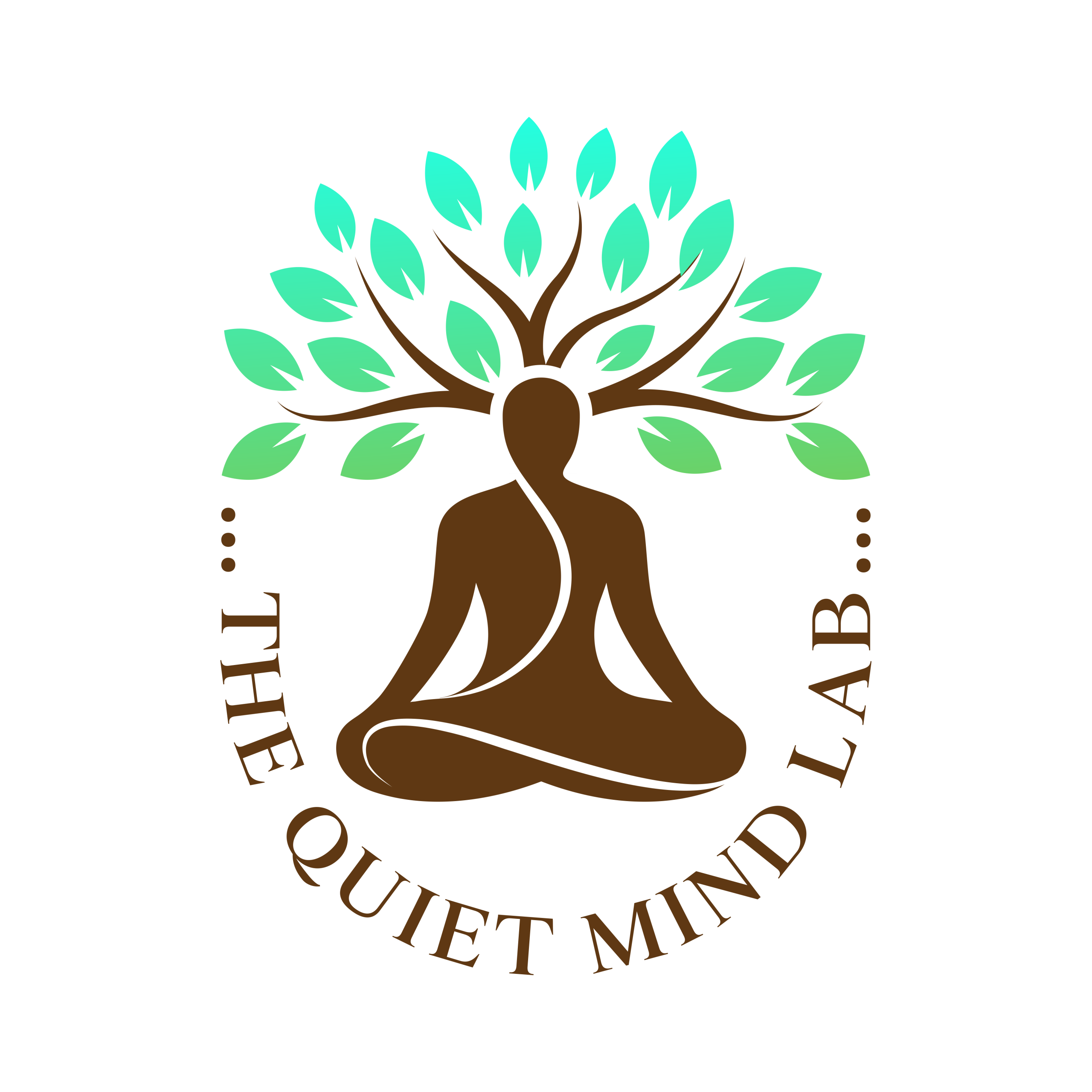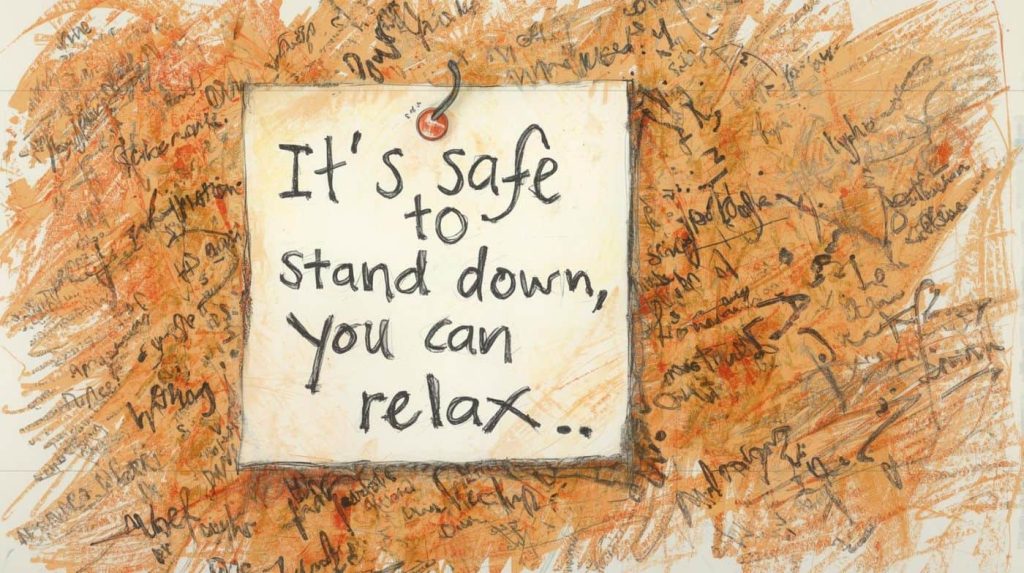You’ve probably heard meditation can “change your life”.
It’s on every wellness list, every podcast, every “how to be less stressed” guide.
But when you actually sit down to try it, what happens? For most of us starting out, we get bored, distracted, itchy, and end up thinking about what’s for dinner.
Still… something about it keeps people coming back.
Because when you stick with it (even for a few minutes a day) something does shift. Not in a dramatic, incense-and-chanting kind of way, but in the small, everyday moments where life usually trips you up.
If you want some help building that habit, our book series Mindfulness in a Minute offers quick, practical tools to make meditation simple – even when life feels too busy to slow down.
But for now, let’s look at seven real benefits of regular meditation – the kind you can actually feel and see over time – with a bit of real talk and science sprinkled in.
Contents
- Becoming Less Reactive
- Improving Focus
- Reducing Stress
- Improving Sleep
- Discovering a Sense of Calm
- Changes in the Brain
- Cultivating Kindness & Compassion
- How to Actually Make it Stick
- Common Meditation Mistakes
- FAQ’s: Common Questions
- The Quiet Power of Practice
YOU STOP REACTING TO EVERYTHING
You know that little jolt you get when someone cuts you off in traffic, or your phone pings mid-conversation? That’s your mind’s autopilot in action – the “fight, flight, or send-an-angry-text” system.
The mind’s first move is almost always react. And before we know it, we’ve sent the snappy reply, raised our voice, or burned through an hour replaying what someone said.
Meditation inserts a fraction of space between the stimulus and our response, and within that tiny gap is a profound source of mental and emotional freedom.
From a biological angle, here’s what’s happening: Meditation helps calm the amygdala, the brain’s threat detector (the bit that fires when you feel attacked, criticised, or stressed). At the same time, it strengthens the prefrontal cortex, which handles reasoning and self-control. In one Harvard study, regular meditators showed less amygdala activation when stressed and more activity in the regions that regulate emotion.
In normal-person terms: the part of your brain that freaks out learns to relax, and the part that makes thoughtful decisions learns to step in sooner.
It’s not about becoming emotionless; it’s about staying conscious and present when emotion hits. You’ll still get annoyed when someone cuts you off – you just don’t carry it for three more exits.
Try this simple test next time something irritating happens:
Notice the first two seconds. Feel the surge of emotion (the heat, the impulse to react) but don’t act. Take one slow breath, then decide how you want to react.
That pause is mindfulness doing its job. It’s microscopic at first, but over weeks it compounds into something bigger: you start choosing your responses instead of being hijacked by them.
The benefit isn’t theoretical; it’s lived every time you don’t bite, snap, or spiral.
Again, regular meditation doesn’t remove those reactions, but it does help to give you a pause before you act on them. You still feel annoyed, but you notice it. And that split-second of awareness can stop you from saying or doing something you’ll regret.
Translation: you start handling stress like an adult rather than a fire alarm.
YOUR FOCUS GETS SHARPER (AND LESS FRAGILE)
Here’s a quick experiment: try reading this paragraph without checking your phone, glancing at another tab, or wondering what’s for dinner.
Hard, isn’t it?
Modern life has turned attention into an endangered species. Between notifications, half-watched videos, and the quiet itch to “just check one thing”, we’ve trained our brains to operate in constant micro-distraction mode.
Meditation, in its basic form, is just strength training for focus. Every time your mind drifts away from the breath – and you gently bring it back – you’re performing a rep. One mental bicep curl at a time.
What’s powerful is how small that motion is: just noticing you’ve wandered and choosing to return. That single act builds awareness and discipline without any force or punishment.
Over time, this simple repetition changes how your brain works. MRI studies have repeatedly shown that regular meditators develop stronger connections in the anterior cingulate cortex – the area that handles sustained attention and cognitive control. Another study from the University of California found that even after two weeks of daily practice, participants performed better on tasks that required focus and working memory.
The benefit shows up everywhere in normal life:
- You finish a task before opening a new tab.
- You listen all the way through a conversation instead of planning your next line.
- You cook, drive, walk – and actually notice you’re doing it.
It’s not that meditation magically banishes distraction; it just helps you see it sooner. You start catching yourself in the act of drifting, and that awareness is half the battle.
Here’s a short, practical way to feel this shift:
Next time you transition between activities – say, from replying to messages to starting a meeting – pause for ten seconds. Notice the urge to rush. Feel one breath. Then move.
That micro-pause acts as a kind of reboot for your brain, clearing the mental noise before it carries over into the next thing.
Over weeks and months, this kind of clarity compounds. Tasks that once felt like a blur become distinct again, and you focus for longer, with less strain. You might still get distracted (everyone does) but you start to recover in seconds instead of minutes.
That’s what “better focus” really means: not never drifting, but knowing how to come back.
When your focus starts to sharpen, something else changes too. You begin to notice how much of your attention was being spent on stress – the background hum you barely registered because it was always there.
It’s the invisible tax of modern life: juggling tasks, absorbing noise, and bracing for the next thing. Meditation doesn’t remove the noise, but it changes how your body and mind respond to it, and that’s where the next big shift appears.
STRESS DOESN’T STICK AS MUCH
Most of us don’t even notice how much low-level stress we carry until it finally crashes – a tension headache, a tight chest, the short fuse that snaps at nothing.
Modern life trains the body to stay in fight-or-flight mode almost constantly. Emails, traffic, arguments, deadlines – the body reacts to all of it as if it’s running from a tiger. The problem is, there’s no tiger. Just a string of small, constant, perceived threats that keep your system buzzing.
One of the most significant benefits of regular meditation is that it teaches your body how to gently hit the brakes. When you slow your breathing and let attention settle, you activate the parasympathetic nervous system – the “rest and digest” response that tells your heart rate, hormones, and muscles it’s safe to stand down.
This is another benefit that science can actually confirm. A recent PubMed study found that just three days of mindfulness training significantly reduced cortisol levels and emotional reactivity during stressful events. Likewise, the earlier Harvard study we mentioned discovered similar effects: after eight weeks of meditation, subjects showed less activity in the amygdala (the brain’s alarm centre) even when exposed to emotional triggers.
The real-world impact feels smaller but deeper:
- That wave of anxiety before a job interview fades faster.
- You stop replaying conversations long after they’re over.
- Your body feels like it can exhale again.
It’s not that life suddenly becomes peaceful; it’s that stress doesn’t linger like it used to.
You’ll still feel tension, but it passes through instead of embedding itself. Think of it like a sponge slowly turning into a sieve: same amount of water, less soaked in.
If you want to feel this shift for yourself, try this 2-minute reset:
Sit upright. Breathe in through your nose for a count of four. Exhale slowly through your mouth for a count of eight. Repeat that five times.
That longer exhale stimulates the vagus nerve – a built-in “calm switch” that signals your body to relax.
It’s surprisingly simple, and when you repeat it daily, your nervous system starts learning that you don’t have to live on high alert all the time.
The benefit of regular meditation isn’t that stress disappears. It’s just that you stop absorbing every stressful thing that happens. You start letting it move through you, and that’s a different kind of strength entirely.
Once stress begins to settle, another ripple effect quietly follows. You start to notice the difference between being tired and being rested.
Because when your body finally stops living in constant alert mode, sleep starts to feel different too – not like something you collapse into, but something that actually restores you.
YOU START SLEEPING BETTER
If you’ve ever climbed into bed exhausted only to have your brain start filing paperwork at full volume, you’re not alone. That restless “mind won’t shut up” feeling is one of the most common side effects of modern overstimulation.
Another benefit of regular meditation is that it helps train the mind to settle before you hit the pillow. When you practice noticing thoughts and letting them pass, you’re rehearsing the same skill that makes it easier to fall asleep – non-engagement.
A landmark randomized controlled trial published in JAMA Internal Medicine found that older adults with moderate sleep issues who completed a six-week mindfulness program experienced significant improvements in sleep quality and daytime fatigue compared to those who took a standard sleep-education course.
What’s happening physiologically is just as interesting. Regular meditation lowers nighttime cortisol, slows heart rate, and reduces activity in the Default Mode Network (the brain system responsible for mental wandering and self-talk). Less background noise means your body can transition into deeper sleep stages faster.
The result isn’t necessarily that you sleep longer; it’s that you sleep better. You wake up with less of that groggy, “was-I-even-asleep” feeling because the mind has been trained to power down more efficiently.
You can test this tonight with a 5-minute pre-sleep scan:
Lie on your back, close your eyes, and move your attention slowly from the crown of your head to your toes. If your mind drifts, no problem – just return to where you left off. By the time you reach your feet, most people are already half-asleep.
If you’d rather follow a guided version, try one of our Guided Sleep Meditations – designed to calm the mind and ease you gently into rest.
The goal isn’t to “make” sleep happen; it’s to remind your body that it already knows how. Do it consistently, and bedtime stops being a fight. It becomes another small meditation – quieter, slower, and finally, restful.
Once you’ve experienced even a few nights of real rest, another shift becomes noticeable. You stop chasing calm as something you have to reach, and start recognising it as something that’s been underneath all along.
That’s one of the most profound benefits of regular meditation: it doesn’t give you calm, it just removes the clutter that keeps you from noticing it.
YOU ACTUALLY START TO FEEL CALMER
Most of us think of calm as a mood – something we feel after the problem’s solved, the inbox’s cleared, the chaos has passed. But calm isn’t a finish line; it’s a baseline. And you only start to feel that when you stop trying so hard to be calm.
Meditation shifts your relationship with discomfort. Instead of running from restlessness, you start sitting with it.
That doesn’t sound glamorous, but it’s a subtle and radical change: you stop adding resistance to every unpleasant moment.
Think about how much of daily stress comes from wanting things to be different than they are – traffic should move, people should listen, the kids should behave differently. Meditation trains you to see those reactions as thoughts, not facts.
And with practice, you learn to stay open even when things aren’t ideal. That openness is calm – not a lack of feeling, but a lack of friction.
Again, neuroscience backs this up. A study published in PNAS found that regular mindfulness practice decreases activity in the default mode network (the brain system tied to self-referential thinking and rumination). This reduction in “mental noise” helps explain why meditators report feeling less reactive and more at ease, even under pressure.
In plain English: when you stop looping on yourself, life feels lighter. It’s not that external chaos disappears, it’s that your mind stops amplifying it.
You’ll notice this calm sneaking into small places first:
- You get cut off in traffic and just… let it go.
- Someone criticises you and, for once, it doesn’t ruin your day.
- You spill coffee, laugh, and move on.
Calm becomes something you live, not chase. Not because life is suddenly easy, but because your nervous system has stopped bracing for impact every five minutes. And once that happens, your attention is free for something else entirely: growth.
YOUR BRAIN ACTUALLY CHANGES
If meditation still sounds like something that just “feels good”, here’s the part that usually surprises people: it actually leaves physical fingerprints on the brain.
Neuroscientists call this neuroplasticity – your brain’s ability to rewire itself based on what you repeatedly do. And meditation is, quite simply, brain training.
In one of the most cited studies on the subject, researchers at Harvard and Massachusetts General Hospital found that participants who completed an eight-week Mindfulness-Based Stress Reduction (MBSR) program showed measurable increases in grey matter density in brain areas linked to learning, memory, and emotional regulation. That’s in just two months.
To put it plainly: eight weeks of sitting still changed the physical structure of people’s brains.
They also found decreases in grey-matter density in the amygdala, the brain’s fear and stress centre. Participants not only felt less stressed – the part of their brain responsible for sounding the alarm had literally quieted down.
More recent research backs this up. Studies at Mount Sinai School of Medicine and University of Wisconsin-Madison have shown that mindfulness meditation increases functional connectivity between brain regions that manage attention and emotional control.
In long-term practitioners, these changes appear to last, suggesting the effects are cumulative rather than temporary.
You can think of it like updating your brain’s operating system:
- Emotional crashes become less frequent.
- Recovery from stress speeds up.
- Attention feels smoother, less jumpy.
And here’s what’s interesting: these benefits don’t require monk-level discipline. Even ten minutes a day of focused attention has been shown to alter neural pathways related to attention and sensory processing.
The science is still evolving, but the trend is clear – meditation isn’t a placebo; it’s structural maintenance for the mind.
Once the brain starts rewiring itself in quieter, healthier ways, the change doesn’t stay trapped in your head either. It starts leaking out, into how you talk to people, how you handle frustration, and even how you treat yourself.
This is one of the most underrated benefits of regular meditation – it doesn’t just make you calmer or more focused; it can actually make you kinder.
YOU BECOME A BIT NICER TO YOURSELF (AND OTHERS)
No one teaches us how loud our own inner critic is until meditation holds up a mirror to it. You sit for five minutes and suddenly hear it: the endless commentary, the judgement, the replay reel of “shoulds” and “not good enoughs”.
At first it’s uncomfortable, but over time, something subtle happens – you stop believing every word of it.
Meditation builds what psychologists call meta-awareness: the ability to notice thoughts as events in the mind rather than truths about reality. That small separation softens self-criticism, and you start recognising that the voice in your head isn’t you; it’s just mental weather passing through.
This shift isn’t just anecdotal – it’s measurable. A 2013 study from Emory University found that participants who practiced compassion meditation for eight weeks showed increased activity in brain regions associated with empathy and emotional understanding, particularly the temporoparietal junction and medial prefrontal cortex.
In other words: regularly cultivating awareness and compassion literally strengthens the circuits that make us better at caring.
Another study at the University of Wisconsin–Madison, led by Richard Davidson, found that loving-kindness meditation increased positive emotions and overall life satisfaction over time, while reducing symptoms of anxiety and depression.
What’s striking is how naturally these changes unfold. You don’t sit down trying to become a better person; you just pay attention, notice your mind’s noise, and stop acting from it so much.
As a result:
- You speak to yourself with a bit more patience.
- You give people the benefit of the doubt.
- You start to sense that everyone else is carrying invisible weights too.
Kindness becomes less of a moral effort and more of a reflex. And in a world that rewards speed, certainty, and outrage, that’s a rare kind of evolution.
HOW TO ACTUALLY MAKE MEDITATION STICK
All of this sounds great, but here’s the catch: none of it works if you only do it once a month.
The benefits of regular meditation come from… (you guessed it) meditating regularly!
The key is to start small.
Two minutes in the morning before you brush your teeth, and five minutes before bed instead of that last scroll through your phone.
Don’t worry about doing it perfectly. If your mind wanders a hundred times, good – that’s a hundred chances to bring it back.
And if you want to make it a habit, tie it to something you already do – like brushing your teeth or making coffee. Sit, breathe, and notice. That’s it.
You don’t need candles, crystals, or a Himalayan retreat. Just a chair, a few minutes, and a willingness to see what’s actually going on in your own head.
And if you skip a day, don’t start the mental guilt trip. Meditation is more like physical training than moral virtue: miss a session, and you simply pick up where you left off. What matters is returning.
Within a month of daily practice, you’ll likely notice the early benefits: less reactivity, lighter sleep, calmer mornings. Give it two or three months, and you’ll start to feel it not just in your mind but in your whole nervous system – a baseline sense of peace that lingers even during the most difficult days.
COMMON MEDITATION MISTAKES (AND HOW TO AVOID THEM)
Once you start meditating regularly, something funny happens: you realise how many ways you can overcomplicate something that’s meant to be simple.
You read too much about it, start comparing yourself to YouTube monks, and before long you’re stressing about whether you’re doing it “right”.
Which is ironic, considering the whole point is to stress less.
So before we wrap up, let’s clear away a few of the biggest misunderstandings that trip people up.
Mistake #1 – Trying to “clear your mind”
This is the most common one, and it’s almost guaranteed to fail.
The goal of meditation isn’t to stop thinking; it’s to notice thinking. When you catch your mind wandering, that’s not failure; that’s the exact practice of mindfulness itself.
If you could magically silence your thoughts, there’d be nothing to train. So instead of chasing emptiness, just notice: There goes a thought. Then come back – that’s the foundation of the practice.
Mistake #2 – Expecting instant calm
It’s natural to want instant results, but meditation works more like building a muscle.
The first few sessions might even make you feel worse – you finally stop moving, and all the mental noise you’ve been ignoring shows up. But rest assured – that’s progress, not punishment.
Stick with it. A few minutes of daily stillness rewires the stress response over time.
Mistake #3 – Discomfort means you’re doing it wrong
Your legs ache, your back complains, and your mind keeps negotiating how much longer you’ll sit.
That’s all part of the process. Meditation reveals what’s already there (tension, restlessness, boredom included!) so you can learn to relate to it differently. If it gets physically painful, adjust your posture; if it’s mental discomfort, stay curious. The moment you stop fighting it, the edge usually softens.
Mistake #4 – Being inconsistent
Meditating every now and then still feels nice, but consistency is where the deeper changes happen.
Every time you meditate, you reinforce neural pathways linked to attention and calm. Miss too many days, and the brain defaults to old habits – just like skipping a workout will cause you to lose strength and size gains.
The fix this, the best advice is to keep the practice small and manageable. Two minutes still counts, and it’s far better than zero minutes. Just remember, it’s far easier to grow a small daily habit than restart a big one every few weeks.
Mistake #5 – Turning meditation into a self-improvement project
It’s easy to treat meditation like another thing to master or perfect.
But the paradox is that it works best when you drop the agenda. You’re not meditating to become a better version of yourself; you’re learning to befriend the one that’s already here.
So rather than grading each session – Was I calm enough? Focused enough? – just notice how the day feels after you’ve practiced. That quiet shift is the whole reward.
Once you stop fighting meditation – stop chasing perfection, stop using it as another way to measure yourself – something clicks. It stops being a task on your list and starts becoming part of the rhythm of your life.
FAQs: COMMON QUESTIONS ABOUT MEDITATION
1. How long should you meditate each day?
You don’t need long sessions to see results. Most studies suggest that 10 – 15 minutes a day of mindfulness practice can improve focus, stress, and emotional balance within a few weeks. If that still feels daunting, start with two minutes. The key is repetition, not duration. Meditation works like physical training – a few mindful minutes every day build more strength than an occasional marathon session. Over time, you can extend naturally as it becomes part of your routine.
2. Is morning or night better for meditation?
Both work, it just depends on what you need. Morning meditation sets a calmer tone for the day and makes it easier to handle stress before it builds. Evening meditation helps unwind tension and prepare your body for rest. Some people do both: a short focus session in the morning, and a slower, body-based meditation at night. Try each for a week and see which fits your rhythm – the best time is the one you’ll actually keep.
3. What happens if you meditate every day?
Consistency reshapes how your brain and body handle stress. Studies show that regular daily meditation can lower cortisol, improve emotional regulation, and even increase grey matter in areas linked to learning and memory. Over time, you’ll probably notice you react less, focus longer, and recover from challenges faster. The change is subtle at first (a pause before snapping, a calmer start to the morning) but it compounds. Daily practice isn’t about doing it perfectly; it’s about remembering to return.
4. Can meditation really change your brain?
Yes. Brain imaging studies from Harvard and other research centres have shown that eight weeks of consistent meditation can increase grey matter in the hippocampus (linked to memory and learning) and reduce density in the amygdala (linked to stress and fear). This process, called neuroplasticity, means your brain literally reorganises itself based on how you use it. Think of meditation as strength training for attention and emotional regulation – quiet, invisible, but profoundly physical.
5. Can meditation replace therapy or medication?
Meditation can support mental health, but it’s not a substitute for professional care. If you’re struggling with anxiety, depression, or trauma, mindfulness can complement therapy or medication (helping you build awareness, stability, and self-compassion) but it shouldn’t replace evidence-based treatment. Many therapists now integrate mindfulness into their work for this reason. If you’re unsure where to start, talk with a qualified mental health professional who understands both clinical care and mindfulness approaches.
6. What if I can’t stop thinking while meditating?
Then you’re doing it right. The mind thinks – that’s its job. The practice isn’t about stopping thoughts but learning to notice them without getting dragged away. Every time you realise your mind has wandered and gently return to the breath, that is meditation. Think of distractions as your training weight: they build awareness each time you lift them and let them go. Over time, the gaps between thoughts naturally widen. Not because you forced silence, but because you stopped fighting noise.
7. Do I have to sit cross-legged to meditate?
Absolutely not. The best position is one that keeps you comfortable and alert. You can sit on a chair with your feet flat, kneel on a cushion, or even lie down if you can stay awake. What matters is an upright, relaxed posture that allows you to breathe freely. Meditation isn’t about how you look; it’s about how you pay attention. If your body’s tense, your mind will be too, so find a position that feels comfortable and natural, and you’re already halfway there.
THE QUIET POWER OF PRACTICE
At some point, you stop asking whether meditation “works”. You just start noticing that you work differently.
The world doesn’t get quieter – traffic still jams, people still frustrate you, the news still overwhelms – but the noise stops getting inside your head quite as easily, and you start carrying a little space with you.
That space is what all this practice builds. Not perfection, or enlightenment, but room between thought and action, between tension and breath, and between you and whatever the world throws your way.
You realise meditation isn’t about becoming calm or wise or endlessly patient. It’s about remembering, moment to moment, that you have a choice. A choice to notice before reacting, to pause before spiralling, and to breathe before deciding how to act.
The benefits of regular meditation aren’t rewards for effort – they’re what naturally emerge when you stop feeding the chaos.
So sit for two minutes today. Then again tomorrow. Even if your mind won’t shut up, even if you feel like you’re doing it badly.
That’s how every seasoned meditator started: one distracted breath at a time. And eventually, in between all those breaths, you’ll catch it – that small, unmistakable moment of stillness that’s been underneath everything all along.
That’s the quiet mind you’ve been looking for. And it’s been there all along.








